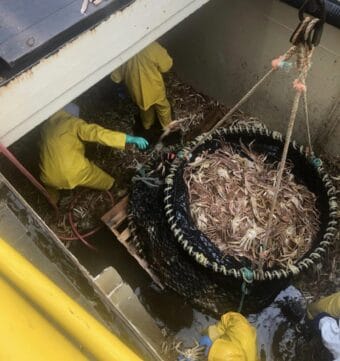
The 2014 to 2016 Pacific marine heat wave, nicknamed “the Blob,” devastated Alaska’s marine ecosystem.
It turned seastars to goo and caused dead seabirds to wash up on beaches. Researchers also believe it killed almost half the resident humpback whales in Glacier Bay and Icy Strait.
But wildlife biologist Janet Neilson with Glacier Bay National Park says things are looking up for Southeast Alaska’s humpback whales.
“The good news is that whales are very resilient,” Neilson said. “They are really capable of rebounding.”
Glacier Bay and Icy Strait are an essential feeding ground for humpback whales. They fuel up before migrating to winter breeding grounds in Hawaii and Mexico. During the heat wave, cold-water fish and plankton species declined, causing what Neilson calls an “underwater famine.”
In the years since, almost 50% of humpback regulars in Glacier Bay and Icy Strait have gone missing — and they haven’t been located anywhere else. Most are presumed to have died because of the heat wave.
Though temperatures cooled down after 2019, Neilson says that for several years, her team kept seeing devastating survey results.
“We almost call it like the hangover of the heat wave,” Neilson said. “Things actually got worse after the heat wave ended before they started to get better.”
But the 2022 update, which was released last week, shows sure signs of improvement. Whales are fattening up again, and they’re staying longer in Glacier Bay and Icy Strait than they did during the heat wave — which points to a much-needed improvement in feeding conditions.
“We’re seeing less emaciated whales. Less skinny whales,” Neilson said.
Southeast humpbacks are also reproducing more successfully, with fewer sudden calf deaths. But birth rates still have not returned to pre-heat wave levels. Scientists don’t know the exact cause, but Neilson says that may mean female whales have not recovered enough nutrition to support pregnancies.
“A lot of females that we would expect to have calves. They’re just not coming back with calves,” Neilson said. “We’re not sure what’s the problem there.”
And for adult whales, the threat of vessel strikes still looms. 2022’s survey documented at least one death of an adult female whale near Angoon. The survey found only 165 adult humpbacks total in Glacier Bay and Icy Strait, so one death can matter a lot.
As the ratio of whale watching boats to individual whales in Southeast is increasing, researchers fear the risk of disturbances is rising too. Too much boat activity can stress humpbacks, which makes proper feeding even more difficult.
Neilson says that avoiding extra stress and deaths for humpbacks will be especially important as climate change increases the chance of future marine heat waves. But for now, she says Southeast’s humpbacks are on a good track.
“Things definitely are still not back to where they were,” Neilson. “But there are positive signs.”



